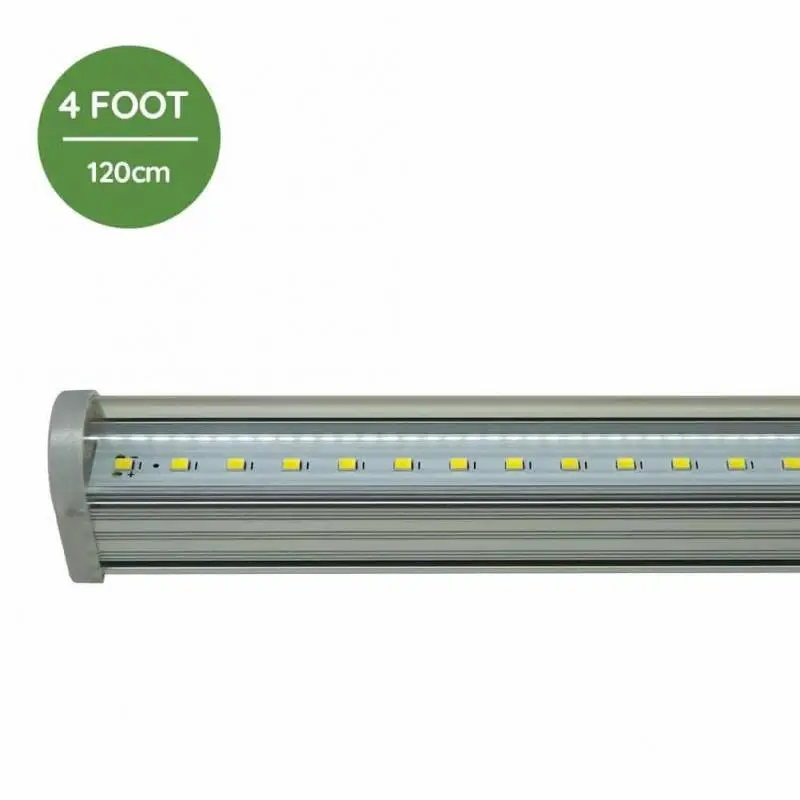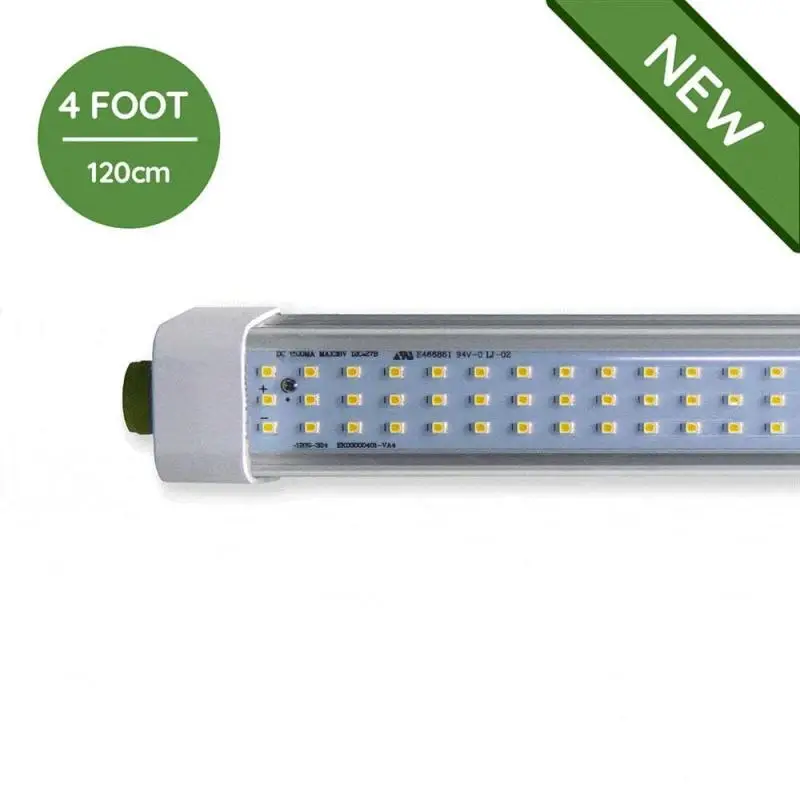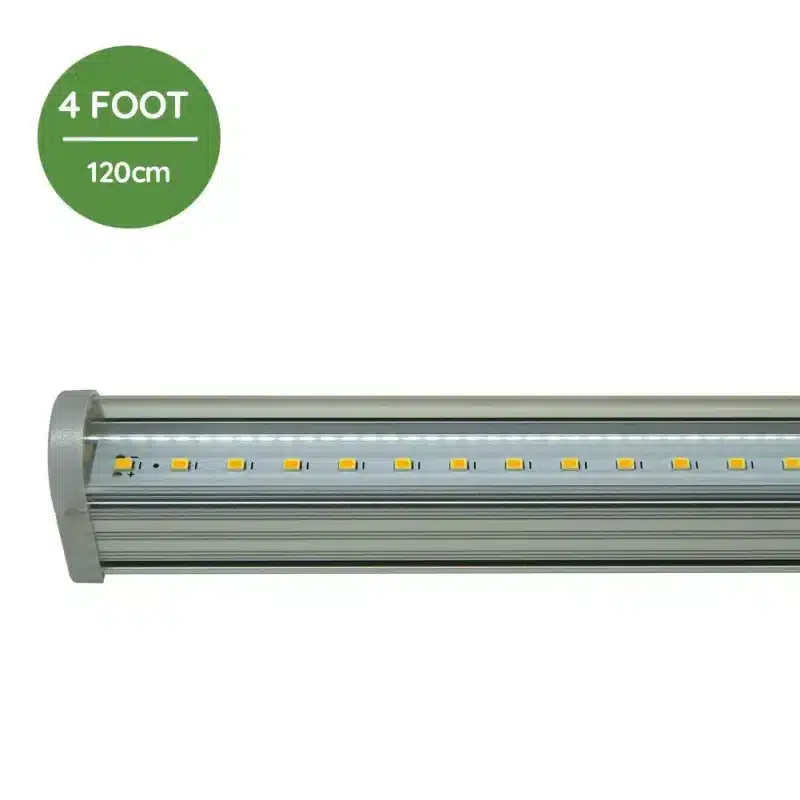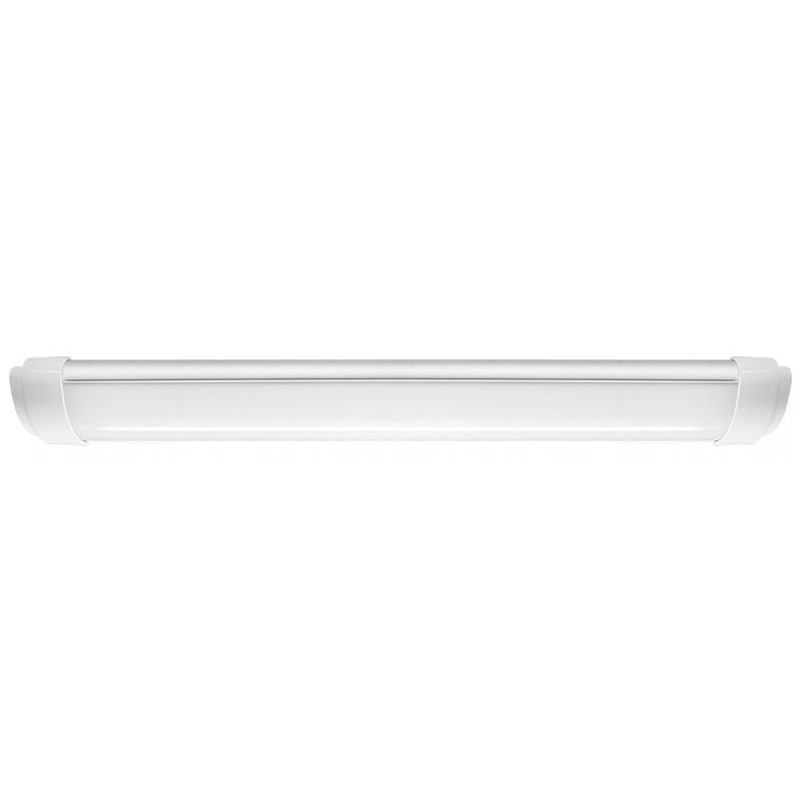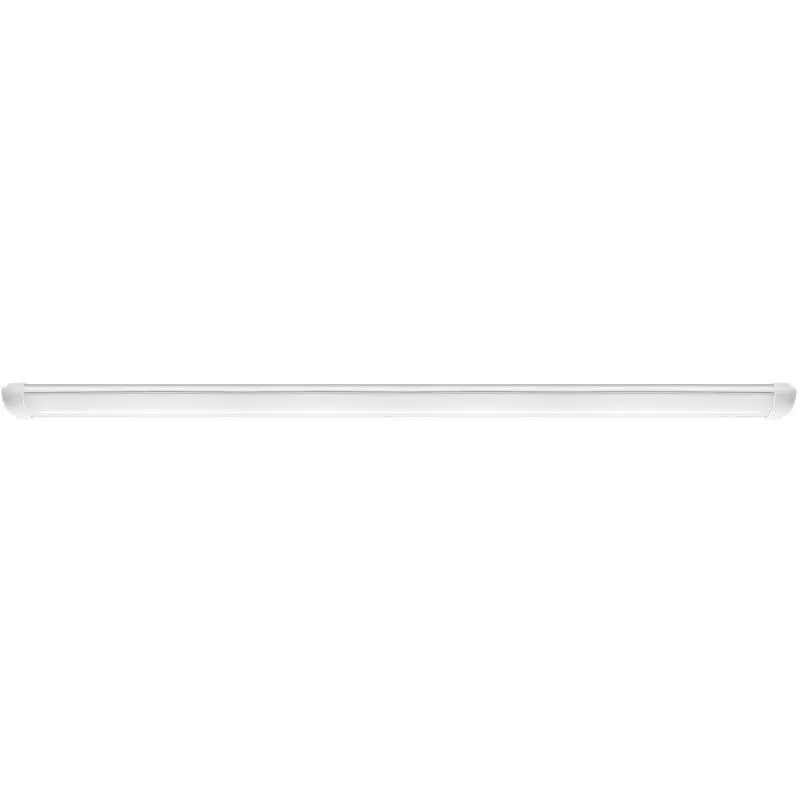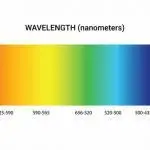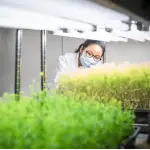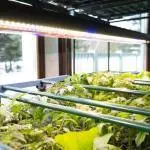Grow indoors all year with Grow Lights
Extend your growing season to all year around with our grow light selection suitable for microgreens, leafy greens and flowering plants! If you are growing indoors or have low-natural light availability then you will .benefit from using grow lights.
Microgreen Grow Light Shop
Hortitek 20W Growsaber LED 6500K 600MM
Hortitek 40W Growsaber LED 6500K 1200MM
Hortitek 10W Growsaber LED 6500K 300MM
Hortitek 30W Growsaber LED 6500K 900MM
Hortitek 60W Growsaber LED 6500K 1500MM
Which Grow Light for Microgreens?
You are going to use 6500K lights for microgreens and other leafy greens and 3000K for flowering plants. Please contact us if you need guidance on lights suitable for your application.
LED lights that are suitable for multi-shelf racks that provide coverage for 4 x 1020 microgreen trays per 120cm shelf (note the exception of the 2ft pack which is designed for small kits).
Why use Grow Lights?
While, ideally, light would be provided entirely by the sun, the reality is that if you are growing microgreens indoors it is entirely likely that you will need to provide supplemental light to ensure consistent growth. Even in outdoor situations, light is not always assured to provide consistency. Seasonality in different parts of the world can be extreme, and even on a day-by-day basis sunlight is variable based on weather conditions.
Growing indoors may be a decision made to control other variables such as temperature, humidity and pest-control. Certainly in a commercial operation you need to be able to control as many variables as you can and this is where grow lights become part of your solution.
Grow Light Q&A
For most microgreen growers, LED grow lights are the best option. Here's a breakdown of why:
LED Grow Lights:
Energy Efficiency: LEDs use significantly less energy than other types of grow lights, like fluorescent or HID, which can save you money on electricity bills.
Low Heat Output: LEDs produce minimal heat, reducing the risk of burning your microgreens or overheating your growing space.
Full Spectrum Options: Many LEDs offer full-spectrum light, which mimics natural sunlight and provides a balanced spectrum for healthy microgreen growth.
Longevity: LEDs have a long lifespan, so you won't need to replace them as frequently as other types of grow lights.
Compact Size: LEDs come in various forms, including compact bulbs, panels, and strips, making them easy to fit into different growing setups.
Other Options:
While LEDs are generally preferred, other grow lights can also be used for microgreens:
Fluorescent Grow Lights: These are a more traditional option and can be suitable for microgreens, especially T5 fluorescent tubes. However, they are less energy-efficient and produce more heat than LEDs.
HID Grow Lights: These are typically used for larger plants or commercial growing and are not as suitable for microgreens due to their high heat output and intensity.
Factors to Consider When Choosing Grow Lights:
Spectrum: Look for full-spectrum lights that mimic natural sunlight or those with a higher proportion of blue light, which promotes leafy growth in microgreens. 6500K is ideal for microgreens.
Intensity: Choose lights with an appropriate intensity for microgreens, typically around 200-400 µmol/m²/s.
Coverage: Consider the size of your growing area and choose lights that provide adequate coverage.
Budget: LEDs can be more expensive initially but offer long-term cost savings due to their energy efficiency and longevity.
Features: Some grow lights come with additional features like timers, dimmers, or adjustable spectrum, which can be helpful for optimizing your microgreen growing.
Ultimately, the best grow light for you will depend on your specific needs and budget. Consider the factors mentioned above and do some research to find the best option for your microgreen growing setup.
The cost of running grow lights can vary significantly depending on several factors, but it's not necessarily expensive, especially for small-scale microgreen growing. Here's a breakdown:
Factors that influence cost:
- Type of grow light: LED lights are the most energy-efficient option and have become increasingly affordable. They use less electricity compared to traditional options like fluorescent or HID lights.
Wattage: Higher wattage lights consume more energy and cost more to run. However, they also provide more light, which might be necessary for certain types of microgreens or larger growing areas.
Hours of use: The more hours you use the grow lights each day, the higher the electricity cost will be. Microgreens typically need 12-16 hours of light per day.
- Electricity rates: Electricity costs vary depending on your location and your electricity provider.
Estimating the cost:
To estimate the cost of running grow lights, you need to consider the following:
- Light wattage: Find the wattage of your grow light.
- Hours of use: Determine how many hours per day you'll be using the light.
- Electricity rate: Check your electricity bill for your rate per kilowatt-hour (kWh).
Here's a simplified example:
- You have a 100-watt LED grow light.
- You use it for 14 hours per day.
- Your electricity rate is $0.15 per kWh.
Calculation:
- Daily energy consumption: (100 watts / 1000) x 14 hours = 1.4 kWh
- Daily cost: 1.4 kWh x $0.15/kWh = $0.21
- Monthly cost: $0.21/day x 30 days = $6.30
Tips for reducing costs:
- Choose LED lights: They are the most energy-efficient option.
Use timers: Automate the on/off cycles of your lights to avoid wasting energy.
- Optimize lighting: Ensure the light is focused on your microgreens and not wasted on surrounding areas.
- Consider natural light: Supplement grow lights with natural sunlight whenever possible.
Overall:
Running grow lights for microgreens doesn't have to be expensive. By choosing energy-efficient lights, optimizing their use, and considering your electricity rates, you can keep the costs manageable while enjoying the benefits of growing your own fresh microgreens year-round.
Grow lights are generally safe for humans when used properly. However, some grow lights can emit harmful radiation, such as ultraviolet (UV) light, which can damage the skin and eyes. It is important to choose grow lights that are designed for indoor use and that do not emit harmful radiation.
- Choose grow lights that are designed for indoor use.
- Do not stare directly at the lights.
- Use protective eyewear if you will be working near the lights for extended periods.
Keep the lights out of reach of children.
- Follow the manufacturer's instructions for use.
- If you have any concerns about the safety of grow lights, consult with a healthcare professional.
Here are some resources that you may find helpful:
Yes, grow lights are generally very good for plants, especially when they don't get enough natural sunlight. Here's why:
- Photosynthesis: Plants need light for photosynthesis, the process of converting light energy into chemical energy for growth. Grow lights provide this essential light, allowing plants to thrive even indoors or in low-light conditions.
Spectrum: Grow lights are designed to emit specific light wavelengths (colors) that plants use most efficiently for photosynthesis. This includes red and blue light, which are crucial for leaf growth, flowering, and fruiting.
Intensity: Grow lights can provide the right intensity of light for different plant species and growth stages. This is important because some plants need more light than others.
Consistency: Unlike natural sunlight, which varies throughout the day and with the seasons, grow lights provide consistent light, ensuring that plants receive the optimal amount they need.
Year-round growing: Grow lights enable you to grow plants indoors year-round, regardless of the weather or season. This is especially beneficial for starting seeds, growing vegetables in winter, or cultivating plants that require specific light conditions.
Types of Grow Lights:
- LED (Light Emitting Diode): These are the most popular type of grow lights due to their energy efficiency, long lifespan, and low heat output. They come in various forms, including bulbs, panels, and strips.
Fluorescent: These are another common type, often used for seedlings and leafy greens. They are less energy-efficient than LEDs but still provide good results.
- HID (High-Intensity Discharge): These are more powerful and typically used for larger plants or commercial growing. They produce a lot of heat and consume more energy.
Choosing the right grow light:
- Plant type: Consider the specific light needs of your plants. Some plants need more light than others. Microgreens prefer the 6500K colour temperature, whereas flowering plants generally prefer the 3000K colour temperature.
- Growth stage: Seedlings and young plants have different light requirements than mature plant.
Space: The size of your growing area will determine the type and size of grow light you need.
- Budget: Grow lights vary in price, so consider your budget when making a selection.
By using grow lights effectively, you can create an optimal growing environment for your plants, ensuring they thrive and produce healthy foliage, flowers, and fruits.
It depends on the type of grow light! Here's a breakdown:
- Most grow lights do NOT emit significant UV: The majority of grow lights, especially LEDs, focus on the visible light spectrum (red and blue light primarily) that plants use for photosynthesis. They don't typically include much UV light.
- Some grow lights DO emit small amounts of UVA: Certain types, like some metal halide (MH) grow lights and some specialized LEDs, may emit small amounts of UVA radiation.
- UVB is usually absent: UVB, the type of UV that causes sunburn in humans, is generally not emitted by standard grow lights.
Why is this important?
- Plant benefits: While plants don't need UV for basic photosynthesis, some studies suggest that small amounts of UVA can benefit plant growth, resilience, and even increase the production of beneficial compounds in some plants.
- Human safety: Excessive exposure to UV radiation can be harmful to humans, causing skin and eye damage. If your grow lights emit UV, it's important to take precautions like:
- Avoiding prolonged exposure
- Wearing protective eyewear
- Keeping a safe distance
Specialized UV grow lights:
There are specialized grow lights available that do emit higher levels of UV, particularly UVB. These are often used for specific purposes like:
- Increasing the potency and flavor of medicinal plants: UVB can stimulate the production of certain compounds that enhance the medicinal properties of some plants.
- Improving plant resilience: UV can help plants develop stronger defenses against pests and diseases.
If you're concerned about UV:
- Check the specifications: Look at the product information for your grow lights to see if they emit UV and at what levels.
- Choose LED grow lights: LEDs are generally considered safer as they emit very little to no UV.
- Use protective measures: If your grow lights do emit UV, take precautions to protect yourself.
In most cases, you don't need to worry about UV radiation from grow lights. However, it's always good to be informed and take necessary precautions to ensure both your plants' and your own well-being.
It depends on the type of grow light and how you use it! Here's why:
Direct vs. Indirect Light
- Direct light: Comes straight from the source (like the sun or a spotlight) and casts strong, well-defined shadows.
Indirect light: Is diffused or scattered, coming from a broader area or bouncing off surfaces. It creates softer shadows or no shadows at all.
Grow Lights and Light Type
- Distance matters: A grow light placed very close to a plant can act like direct light, casting strong shadows and potentially even causing light burn if it's too intense.
- Intensity matters: Very powerful grow lights, even at a distance, can create a direct light effect.
Diffused light: Some grow lights have built-in diffusers or can be used with diffusing materials (like sheer curtains) to create a more indirect light effect.
Grow Lights for Different Needs
- Seed starting: Often need bright, direct light for strong germination.
- Leafy greens: Can tolerate a wider range of light, including indirect light.
- Flowering/fruiting plants: Usually require brighter, more direct light.
How to Tell If Your Grow Light is Providing Indirect Light
- Observe the shadows: If the light casts sharp, defined shadows, it's more direct. Soft shadows or no shadows indicate indirect light.
- Consider the distance: The farther the light is from the plants, the more likely it is to provide indirect light.
- Check the light intensity: If the light is very intense, even at a distance, it might be too strong for some plants as direct light.
In Conclusion
Grow lights can provide both direct and indirect light depending on how they are used. By adjusting the distance, intensity, and using diffusing techniques, you can create the right lighting conditions for your specific plants.
Grow lights are generally safe for pets, but there are a few things to keep in mind to ensure their well-being:
Factors to consider:
- Type of grow light:
- LED grow lights: These are generally considered the safest option for pets due to their low heat output and lack of harmful UV emissions.
- Fluorescent grow lights: These can also be safe, but some may emit small amounts of UV, so it's important to choose those specifically designed for indoor use and check their specifications.
- HID grow lights: These are generally not recommended for use around pets due to their high heat output and potential for emitting harmful UV radiation.
- Heat generation: Some grow lights, especially older models or high-intensity ones, can generate significant heat. Make sure your pet can't get too close to avoid burns or discomfort.
- Light intensity: Very bright light can be bothersome to pets, especially if it disrupts their sleep patterns. Consider using timers to control the on/off cycles and provide periods of darkness.
UV emissions: As mentioned earlier, some grow lights emit UV radiation. If yours do, take precautions to limit your pet's exposure.
Tips for keeping pets safe:
- Choose pet-friendly grow lights: Opt for LED grow lights with low heat output and minimal UV emissions.
- Secure the lights: Make sure the lights are securely positioned and out of reach of curious pets who might try to chew on cords or knock them over.
- Monitor your pet's behavior: If your pet seems uncomfortable or avoids the area with the grow lights, consider adjusting the lighting or providing alternative resting spots.
- Consult your vet: If you have any concerns about the safety of grow lights for your specific pet, consult your veterinarian.
Overall:
With a little consideration and the right precautions, grow lights can be used safely around pets. By choosing the right type of light, managing heat and intensity, and monitoring your pet's behavior, you can create a safe and comfortable environment for both your plants and your furry friends.
Grow lights can be a fire hazard if not used carefully and responsibly. However, the risk level varies depending on the type of grow light:
Higher Risk:
HID grow lights (High-Intensity Discharge): These lights, including metal halide (MH) and high-pressure sodium (HPS) lamps, generate a significant amount of heat. If they are placed too close to flammable materials or if the wiring is faulty, they can pose a fire risk.
Lower Risk:
- LED grow lights (Light Emitting Diode): LEDs are generally considered safer than HIDs because they produce much less heat. However, it's still crucial to use them properly. Poor-quality LEDs, faulty wiring, or inadequate ventilation can still lead to overheating and potential fire hazards.
General Fire Safety Tips for Grow Lights:
- Choose quality lights: Invest in reputable brands and avoid cheap, poorly made lights that may have inadequate safety features.
- Proper installation: Follow the manufacturer's instructions carefully when installing grow lights. Ensure proper wiring, secure mounting, and adequate distance from flammable materials.
- Ventilation: Provide good ventilation in your grow space to dissipate heat and prevent it from building up around the lights.
- Regular inspection: Check your grow lights periodically for any signs of damage, wear, or loose connections. Address any issues promptly.
- Avoid overcrowding: Don't overcrowd your grow space with too many lights or plants, as this can increase heat buildup.
- Use timers: Timers can help automate the on/off cycles of your lights, reducing the risk of leaving them on for extended periods unattended.
Fire safety equipment: Keep fire safety equipment, such as a fire extinguisher, readily available in your grow space.
Specific Concerns:
- Overheating: The most common fire hazard with grow lights is overheating. Ensure proper ventilation and avoid placing lights too close to flammable materials like curtains, fabrics, or paper.
- Electrical faults: Faulty wiring, loose connections, or damaged cords can also cause fires. Regularly inspect your equipment and have any electrical issues repaired by a qualified electrician.
Water damage: While less common, water damage to electrical components can also create a fire hazard. Keep your grow lights away from water sources and ensure any spills are cleaned up promptly.
By following these safety guidelines and using grow lights responsibly, you can minimize the risk of fire hazards and create a safe growing environment for your plants.
Yes, grow lights can be very beneficial for orchids, especially if you don't have ideal natural light conditions in your home. Here's why:
- Light Requirements: Orchids generally need bright, indirect light to thrive. Grow lights can supplement or even replace natural sunlight, providing the necessary light intensity and duration for healthy growth and blooming.
Spectrum: Orchids, like other plants, use specific wavelengths of light for photosynthesis. Full-spectrum LED grow lights are a great option as they mimic natural sunlight, providing a balanced spectrum that supports overall plant health and flowering.
Control: Grow lights give you more control over the lighting conditions. You can adjust the intensity and duration of light to meet the specific needs of your orchid species. This is particularly helpful for orchids that require specific light levels or photoperiods (day/night cycles) for blooming.
Placement Flexibility: With grow lights, you're not limited to placing your orchids near windows. You can cultivate them in any location that provides the right temperature and humidity, as long as you provide adequate supplemental light.
Year-Round Growing: Grow lights enable you to provide consistent light for your orchids throughout the year, regardless of the season or weather. This is especially beneficial in regions with limited sunlight during winter months.
Choosing Grow Lights for Orchids:
- LED lights: LEDs are the most popular choice for orchids due to their energy efficiency, low heat output, and long lifespan. Look for full-spectrum LEDs with a color temperature around 5000-6500K to mimic natural sunlight.
- Fluorescent lights: Fluorescent lights can also be used, but they are less energy-efficient and produce more heat than LEDs.
- Light intensity: The intensity of light needed will vary depending on the orchid species. Research the specific needs of your orchid to determine the appropriate light level.
- Distance: Maintain a proper distance between the grow light and your orchids to prevent light burn. Start with the recommended distance provided by the manufacturer and adjust as needed based on your orchid's response.
Additional Tips:
- Use a timer: Set a timer to automate the on/off cycles of your grow lights, ensuring your orchids receive consistent light exposure.
Monitor your orchids: Pay attention to how your orchids respond to the grow lights. Adjust the distance or intensity as needed to optimize their growth and flowering.
- Combine with natural light: If possible, combine grow lights with natural sunlight to provide a more balanced and natural light environment for your orchids.
By using grow lights effectively, you can create an ideal growing environment for your orchids, encouraging healthy growth, vibrant blooms, and overall plant vitality.
While grow lights have come a long way in mimicking sunlight, they're not quite as good as the real deal in all aspects. Here's a comparison:
Sunlight:
- Full spectrum: Sunlight provides the complete spectrum of light, including all the colors of the rainbow and beyond (like UV and infrared). This full spectrum is what plants have evolved to utilize for optimal growth and development.
Intensity: Sunlight can be incredibly intense, providing high levels of energy for photosynthesis. This intensity can be difficult to replicate with artificial lights, especially for plants that require full sun conditions.
Dynamic: Sunlight changes throughout the day and with the seasons, providing natural variations in light intensity and spectrum. This dynamic nature can benefit plant growth and resilience.
Free: Sunlight is a free and readily available resource, making it the most cost-effective option for plant growth.
Grow Lights:
- Spectrum: Modern grow lights, particularly full-spectrum LEDs, can replicate a significant portion of the sunlight spectrum, including the essential red and blue light for photosynthesis. However, they may not perfectly match the full range of wavelengths found in sunlight.
- Intensity: Grow lights can provide varying levels of intensity, but they may not reach the same peak intensity as direct sunlight. This can be a limiting factor for some plants that require high light levels.
- Static: Grow lights typically provide a consistent light output, which can be beneficial for certain plants or growing stages. However, they lack the natural fluctuations and variations found in sunlight.
- Cost: Grow lights require an initial investment and ongoing electricity costs, making them less cost-effective than sunlight.
When Grow Lights Are a Good Option:
- Indoor growing: When natural sunlight is limited or unavailable, grow lights are essential for indoor plant growth.
Supplementing sunlight: Grow lights can supplement natural sunlight, especially during winter months or in low-light conditions.
Specific plant needs: Some plants have specific light requirements that can be better met with grow lights, such as orchids or seedlings.
- Controlled environments: Grow lights allow for greater control over lighting conditions, which can be beneficial for certain growing techniques or research purposes.
Conclusion:
While grow lights are a valuable tool for plant growth, especially in controlled environments or when sunlight is limited, they don't perfectly replicate all the benefits of natural sunlight. Sunlight remains the ultimate source of full-spectrum light and dynamic intensity, making it the ideal choice whenever possible. However, grow lights offer a viable alternative or supplement, allowing for plant cultivation in a wider range of conditions and for specific purposes.
Yes, grow lights can definitely burn plants if they are not used correctly. This phenomenon is often called "light burn," and it can happen with any type of grow light, but it's more common with high-intensity lights like HIDs.
- Intensity: Grow lights emit light at a specific intensity, measured in micromoles per square meter per second (µmol/m²/s) or Photosynthetic Photon Flux Density (PPFD). If the intensity is too high for a particular plant, it can overwhelm the plant's photosynthetic system, causing damage.
Distance: The closer the grow light is to the plant, the higher the light intensity the plant receives. Placing the light too close can lead to light burn, especially for young seedlings or sensitive plants.
Duration: Even if the light intensity is not excessively high, prolonged exposure can also cause light burn. This is why it's important to have appropriate on/off cycles for your grow lights to give plants a dark period to rest and recover.
- Heat: Some grow lights, particularly older models or high-intensity ones, can generate significant heat. This heat can also contribute to burning plants, especially if the light is too close or if there is inadequate ventilation.
Signs of Light Burn:
- Yellowing or browning of leaves: The most common symptom is yellowing or browning of the leaf tips or edges, especially on the leaves closest to the light source.
Leaf curling or wilting: Leaves may curl or wilt as a result of excessive light or heat stress.
Brown spots: Brown spots may appear on the leaves, indicating areas of tissue damage.
Stunted growth: In severe cases, light burn can stunt the overall growth of the plant.
Preventing Light Burn:
- Choose the right light: Select a grow light with an appropriate intensity for your plant species and growth stage.
- Maintain proper distance: Follow the manufacturer's recommendations for hanging distance and adjust as needed based on your plant's response.
- Control light duration: Use timers to provide appropriate on/off cycles and give your plants a dark period.
Monitor plant health: Regularly inspect your plants for any signs of light burn. If you notice any symptoms, adjust the light intensity, distance, or duration accordingly.
Provide adequate ventilation: Ensure good airflow in your grow space to dissipate heat and prevent it from building up around the plants.
If you suspect light burn, take action immediately to prevent further damage. Adjust the light intensity, distance, or duration, and provide optimal growing conditions to help your plant recover.
This is a bit of a tricky question, and the answer is: it's unlikely, but there's not enough research to say for sure. Here's what we know:
UV Radiation: The main concern with grow lights and cancer is UV radiation. Prolonged exposure to high levels of UV radiation, especially from the sun, is a known risk factor for skin cancer.
Grow lights and UV:
- Most grow lights emit very little UV radiation, especially LEDs. They primarily focus on the visible light spectrum that plants need for growth.
- Some grow lights, like certain metal halide lamps, might emit small amounts of UVA. However, the levels are usually not high enough to be a significant concern.
Specialized UV grow lights do exist, but these are typically used for specific purposes and require precautions to avoid overexposure.
Blue Light: There's also some concern about blue light emitted by grow lights.
- Blue light is part of the visible light spectrum and is important for plant growth.
- Some studies suggest a potential link between excessive blue light exposure and an increased risk of certain cancers, but more research is needed.
- The levels of blue light emitted by grow lights are generally not considered high enough to be a major risk factor.
Precautions:
While the risk of cancer from grow lights is likely low, it's still wise to take precautions:
- Choose LED grow lights: LEDs emit minimal UV and are generally considered safer.
- Avoid prolonged exposure: Don't spend excessive amounts of time directly under grow lights.
- Use protective gear: If you work with grow lights extensively, consider wearing protective eyewear and clothing.
- Keep distance: Maintain a safe distance from the lights, especially high-intensity ones.
- Follow guidelines: Adhere to the manufacturer's recommendations for usage and safety.
Overall:
Based on current knowledge, grow lights are unlikely to cause cancer, especially when used responsibly. However, more research is needed to fully understand the long-term effects of exposure to artificial light sources. It's always prudent to take precautions and minimize any potential risks.



